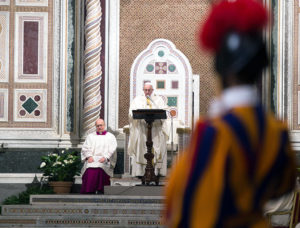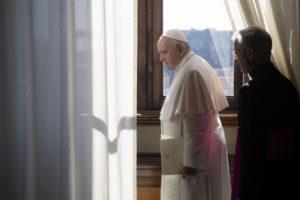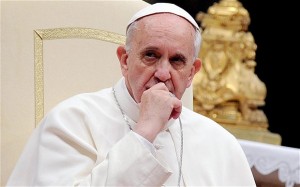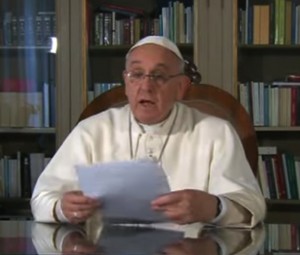
In his final letter, St. Paul gives Timothy an important exhortation for those under his pastoral care:
Remind them of this, and charge them before the Lord to avoid disputing about words, which does no good, but only ruins the hearers (2 Tim. 2:14).
In his previous letter, Paul gives an even more strongly worded warning:
If anyone . . . does not agree with the sound words of our Lord Jesus Christ and the teaching which accords with godliness, he is puffed up with conceit, he knows nothing; he has a morbid craving for controversy and for disputes about words, which produce envy, dissension, slander, base suspicions, and wrangling among men who are depraved in mind and bereft of the truth (1 Tim. 6:3-5)
As you can see, Paul is not a fan of fights about words.
Yet Paul’s letters are filled with arguments about various issues. How can we square these two facts?
The basic resolution is that Paul cares about substance—that is, what a person believes—and he’s willing to argue about that. But he doesn’t want to argue about expression—that is, how a person phrases his beliefs. Paul is concerned about substance rather than style. As long as the substance of what a person believes is correct, Paul doesn’t want to quibble about how expresses himself.
I’m sure there would have been limits to this. I can imagine situations where Paul would have thought a person was expressing a true thought in a manner that was so misleading that he would have considered it worth discussing.
However, the principle remains: We shouldn’t be quarreling about words in the Christian community. We should recognize that a true belief can be expressed in more than one way, and the mode of expression is not what we should be concerned about.
This is especially true in discussions among different groups of Christians. Because language naturally changes over time, it is only to be expected that different Christians will develop their own ways of using language and their own nuances for terms.
Unfortunately, there’s a lot of arguing about words in the Christian community today, and a good bit of it comes from not recognizing how flexible language can be.
People have a natural tendency to assume that words are just meant to be used the way they use them, and if somebody is using them differently, that person must be wrong.
So, let’s look at how some terms have changed over time, and see what conclusions we can draw.
We may learn something about how not to fight about words.
Words that Change Meaning in the Bible over Time
Though it may be surprising, there are terms that shift in their meaning even during biblical history.
That’s what you’d expect, since the Scriptures were written over a period of about 1,100 years, and nobody should expect a community’s mode of expression to stay static over that length of time. (Just look at how English has changed since the year 800!)
The matter is complicated by the fact that, not only did terms change meanings over this period, but the language itself shifted, with God’s people first speaking Hebrew, then Aramaic, and then Greek.
Nevertheless, we can track changes in meaning across biblical vocabulary:
Salvation: The basic meaning of this term is “to rescue” or “to make safe,” but there is a dramatic shift in how it is used between the Old and the New Testaments.
In the Old Testament, salvation is connected almost exclusively with being rescued from temporal dangers—ones we encounter in this life, like war, defeat, famine, plague, or death.
However, in the New Testament, the focus has shifted from this life to the next, and the salvation that is primarily under discussion is being rescued from the consequences of sin so that we can share eternal life with God.
One way of expressing this is that the Old Testament is principally concerned with “temporal” salvation, while the New Testament is principally concerned with “eternal” salvation.
Forgiveness: A corresponding shift is the way forgiveness of sin is understood.
In the Old Testament, being forgiven of a sin principally means not being punished—or fully punished—for it in this life. In particular, it means not dying as a result of the sin.
Thus, when David repents of having brought about the death of Uriah the Hittite, we read:
Then David said to Nathan, “I have sinned against Yahweh!”
Nathan said to David, “Yahweh has also forgiven your sin; you shall not die. But because you have utterly scorned Yahweh in this matter, the son born for you will certainly die” (2 Sam. 12:13-14, LEB).
David had been forgiven in that he would not die, but that doesn’t mean he would escape all punishment. He would be forced to witness the death of his son.
Notice that both of these penalties—David’s death and the death of his son—are temporal rather than eternal.
By contrast, when forgiveness is discussed in the New Testament, it is principally in connection with being forgiven the eternal consequences of our sins, so that we can be eternally saved.
Words that Change Meaning in Different Biblical Passages
Even within a single time period, words can be used in different senses in different biblical passages.
Faith/Belief: A classic example is the term “faith” or “belief” (Greek, pistis). In many New Testament passages, this concept involves trust in God. Thus, when Jesus has rebuked the wind and the waves, he turns to the disciples and says, ““Why are you afraid? Have you no faith?” (Mark 4:40).
However, a different sense of the term is on display in James, who informs us that “Even the demons believe—and shudder” (Jas. 2:19). Here “faith” is understood as a purely intellectual one. Demons know the truths of Christian doctrine, but they lack the more robust faith that involves trust in God.
Still a third usage is found in St. Paul, where he says, “For in Christ Jesus neither circumcision nor uncircumcision is of any avail, but faith working through love” (Gal. 5:6). Here we have faith formed by love (Latin, fides formata caritate), which combines intellectual assent, trust, and charity—the three theological virtues (1 Cor. 13:7).
Words that Change Meaning Between the Bible and the Fathers
Of course, language did not stop developing with the close of the apostolic era, and so we find terms continuing to change in meaning:
Witness/Martyr: The Greek term martus originally meant “witness,” and in this sense we find St. Paul writing:
For God . . . is my witness [martus], how constantly I make mention of you, always asking in my prayers if somehow now at last I may succeed to come to you in the will of God (Rom. 1:9-10).
However, this term came to be associated with those who served as witnesses to the truth of the Faith by giving their lives for it and so being “martyred.”
Following the age of persecutions in the early Church, the term became so associated with being killed for the Faith that people who were not killed became known by other terms, such as “confessors” (those who confessed the Faith under persecution, even though they were not killed).
Today, a popular Christian audience would never understand the term martyr to refer simply to a person who bore witness to something.
Sacrament: The term sacrament (Greek, musterion, Latin, sacramentum) originally meant “secret” or “mystery,” and it occurs in this sense in the New Testament, as when Jesus tells the disciples, “To you has been granted the secret of the kingdom of God, but to those who are outside everything is in parables” (Mark 4:11).
However, in the era of the Church Fathers, the term came much more to be associated with various rites of the Christian faith, such as baptism and the Eucharist.
Eventually, this usage came to predominate, and today nobody would know what you meant if you translated Jesus as saying, “To you has been given the sacrament of the kingdom of God.”
Words that Change Meaning Between the Fathers and the Scholastics
The Middle Ages also saw shifts in terminology that had been present earlier in the tradition:
Anathema: Though this term is found in the Greek New Testament (Gal. 1:8-9) and even has roots in the Old Testament, it shifted meaning over time, and by the Middle Ages it had come to refer to a special form of excommunication.
This form had to be performed by a bishop, who imposed it with a special ceremony. (There was a parallel ceremony for lifting the anathema once the offender had repented—which was a key goal of excommunicating him, to prompt him to repent of sin and come back to God.)
Unfortunately, knowledge of this meaning has been lost in many circles, leading to enormous confusion about the meaning of the phrase anathema sit (Latin, “let him be anathema”) in Church documents.
For example, many in the Protestant community understand anathema to mean something like “damned by God,” and take anathemas to be something that takes effect automatically and is pronounced upon all Protestants.
None of these things are true. In ecclesiastical usage, anathema referred to a special, ceremonial form of excommunication. Because it involved a ceremony, it did not take place automatically, and it was not applied to non-Catholics. Eventually, it was abolished, and it no longer exists in current canon law.
Elect/Chosen: By the Middle Ages, the term elect came to be used for a specific group of people—those who will be saved on the Last Day.
This meaning has been inherited by most contemporary doctrinal traditions, including both Catholic and Protestant ones.
However, this is not how the term is used in the Bible or the earliest Church Fathers—as I document in a study I did of this question. Instead, the primary meaning of elect was being chosen to have a special, intimate relationship with God, but not one that implied salvation on the Last Day.
The model was Israel’s status as God’s “elect” or “chosen people,” which implied a special relationship between them and God but not the final salvation of every single Israelite.
Words that Change Meaning Among Doctrinal Traditions
The fragmentation of Christendom into different doctrinal traditions—especially the fragmentation that occurred following the Protestant Reformation—has led to further developments in how terminology is used:
Law and Gospel: For example, while Law and Gospel are important concepts in the Bible, they have taken on unique usages in the Lutheran tradition. Thus, the Lutheran Book of Concord states:
Anything that preaches concerning our sins and God’s wrath, let it be done how or when it will, that is all a preaching of the Law. Again, the Gospel is such a preaching as shows and gives nothing else than grace and forgiveness in Christ.
It is certainly possible to go through the Bible and identify passages which speak of sin and divine wrath and compare them to passages that speak of grace and forgiveness in Christ, but these are not the primary ways that the biblical authors use the terms law and gospel. They are distinctively Lutheran usages.
In the Bible, the primary conceptualizations of law are either as divine principles given to guide human conduct or, specifically, the Law of Moses (Gen.-Deut.). Similarly, the principal focus of the gospel is God and his actions through his Son, especially Christ’s death and resurrection.
While law is related to sin and wrath, and while the gospel is related to grace and forgiveness, Lutheran theology has developed its own uses for these categories that do not map directly onto the thought worlds of the biblical authors.
Justification: A notable difference has developed in how the term justification is often understood in Protestant and Catholic communities.
The Catholic community uses justification to refer to “not only the remission of sins, but also the sanctification and renewal of the interior man” (CCC 1989). It also uses the term justify to mean “to cleanse us from our sins and to communicate to us the righteousness of God through faith in Jesus Christ” (CCC 1987).
Two elements are thus found in the Catholic use of justification:
1. The remission of sins/being cleansed from sins
2. Inward sanctification/renewal/reception of righteousness from God
For the most part, the Protestant tradition has focused on justification as involving the first of these (with a corresponding understanding of justification as the impartation of legal righteousness), but not the second.
Instead, Protestant schools frequently refer to the inward renewal of the Christian using a second term: sanctification.
Words that Change Meaning Among Theological Traditions
Even within a given doctrinal tradition, different theological schools develop their own nuances for terms:
Regeneration/New Birth: For example, in Protestantism the term regeneration has taken on several meanings.
In Calvinist circles, regeneration is used to refer to a transformative reception of grace that occurs prior to the expression of personal faith and which makes explicit personal faith possible.
In Lutheran circles, regeneration is used to refer to a transformative reception of grace that occurs in baptism, regardless of whether explicit personal faith is present.
In Baptist circles, regeneration is used to refer to a transformative reception of grace that occurs when a person makes an explicit act of personal faith.
Predestination: Similarly, in both Protestant and Catholic circles the term predestination is understood in different ways among different theological schools.
Thus, in the Protestant tradition, Calvinists understand predestination differently than Arminians.
And in Catholic circles, Thomists understand it differently than Molinists.
Some Conclusions
Having gotten a sense of the ways religious terms change across time, what conclusions can we draw?
Principally, we’ve seen that there is no single way to use terms, which is the fundamental reason for Paul’s dictum not to engage in word fights.
The Bible itself shows different usages, both across times and by different authors living in the same time.
Given this diversity in Scripture itself, we should not expect doctrinal vocabulary to be frozen at any given moment in history.
What is normative is the fundamental doctrinal substance of the Faith, which was frozen with the end of public revelation at the conclusion of the apostolic age.
Even then, that fundamental content remained to be meditated upon and further elaborated, with its implications being fleshed out through the process of doctrinal development (which any accurate understanding of the history of Christian doctrine and theology must recognize).
But what are we do to about the different usages that have grown up in the Christian community?
Lest confusion result, each communion should in general retain the usages that have developed within it, though even these are not frozen and are subject to further development with time.
For the sake of accurately understanding of the Bible, of history, and of each other, there also should be an awareness of the way terms have shifted and continue to shift.
- Exegetes need to be aware of how terminology is used in the Bible and how to translate it into the vocabulary of their own traditions—without forcing their tradition’s meanings back onto the biblical text.
- Patristic scholars need to do the same thing with respect to texts from the Church Fathers.
- Historians of doctrine and theology need to do it with the historical texts they study.
- And Christians in dialogue among different doctrinal and theological traditions need to be able to do it across the biblical, historical, and contemporary texts.
Part of learning how not to fight about words is learning to translate between these vocabularies.
For example, when it comes to the terms like justify and justification, we should not suppose that there is only a single way that these can be used—or that Scripture uses them in only one sense (it does not; Scripture has multiple uses for them).
Instead, we should be able to explain how our tradition uses the term and what we mean by it—and be prepared to explain the basis for what we believe.
Catholics and Protestants typically believe in both the forgiveness of sins with an accompanying legal status of being righteous—and a renewal of the inner man by God’s grace.
We do not need to be divided by the terminological issue of whether our community uses justification to refer to just the first of these or to both, as long as we agree on the substance—the fact that both occur.
When it comes to the biblical texts, we need to be prepared to recognize that Scripture may or may not use terms the way that they have developed in our communities. We should not force our doctrinal or theological uses back onto the text.
Instead, we should seek to determine—as best we can—what the biblical authors meant, regardless of whether it corresponds to later uses.
Sometimes, it will. The different uses of faith that are emphasized in different schools today are all found in Scripture. But the conventional meaning of the term elect is not.
It is good—to the extent possible over time—to steer our vocabularies so that they correspond to the way terms are used in Scripture, but language change requires time and cannot be suddenly imposed without causing tremendous confusion and dissension.
Such dissension is precisely what St. Paul sought to avoid by prohibiting quarrels about words. As long as we agree in substance, precisely how we express that substance is a secondary matter, and—even if we think another school is departing from the language of Scripture in how they express themselves and it would be better if they didn’t—we should still be able to recognize it when they are correct in substance.
 This version of The Weekly Francis covers material released in the last week, from 2 January 2025 to 5 February 2025.
This version of The Weekly Francis covers material released in the last week, from 2 January 2025 to 5 February 2025.




